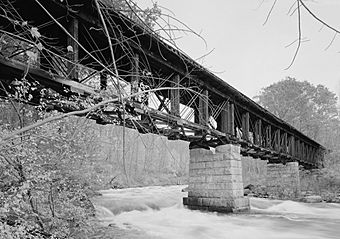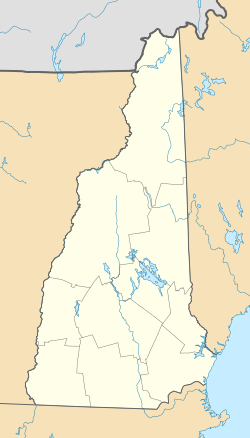Sulphite Railroad Bridge facts for kids
Quick facts for kids |
|
|
Sulphite Railroad Bridge
|
|

HABS/HAER photo, 2003
|
|
| Location | Off US 3 over Winnipesaukee River, Franklin, New Hampshire |
|---|---|
| Area | 0.3 acres (0.12 ha) |
| Built | 1897 |
| Built by | Boston & Maine Railroad |
| Architectural style | Pratt truss |
| NRHP reference No. | 75000130 |
| Added to NRHP | June 11, 1975 |
The Sulphite Railroad Bridge is a special old bridge in Franklin, New Hampshire. People also call it the Upside-Down Covered Bridge. It was built around 1896 or 1897. This bridge carried trains for the Boston and Maine Railroad. It crossed the Winnipesaukee River between Franklin and Tilton.
This bridge is very unique. It's thought to be the only "upside-down" covered railroad bridge left in the United States. This means the train tracks are on top of the bridge's roof. The roof's main job is to protect the parts of the bridge underneath. The bridge was added to the National Register of Historic Places in 1975. It hasn't been used since 1973 and is not in good shape today.
Contents
What Makes This Bridge Special?
The Sulphite Railroad Bridge is about 0.7 miles (1.1 km) east of downtown Franklin. It crosses the river where the banks are quite steep. You can't easily see it from a road. But you can spot it from the Winnipesaukee River Trail.
Bridge Size and Design
The bridge is 234 feet (71 m) long. It has three main sections. Each section is held up by strong supports called Pratt trusses. These supports rest on stone bases or walls. The longest middle section is 180 feet (55 m) long.
Why It's Called "Upside-Down"
This bridge is famous for its "upside-down" design. Most covered bridges have the road or tracks inside the covered part. But on this bridge, the train tracks are on top of the roof. The roof acts like a big umbrella. It keeps the important wooden parts of the bridge safe from rain and snow. This design helped the bridge last longer.
History of the Sulphite Railroad Bridge
The Boston and Maine Railroad built this bridge around 1896 or 1897. It replaced an older bridge from 1892. That first bridge was built by the Franklin and Tilton Railroad.
How the Bridge Got Its Name
The bridge got its name, "Sulphite," because of what it carried. Trains used this line to transport a lot of sulfite. This chemical was used by paper mills in Franklin. These mills were the main reason the train line was so busy.
End of the Railroad Line
The paper mills closed down in the 1920s. This meant fewer trains used the bridge. In 1936, another covered bridge on the same line was washed away by a flood. The entire railroad line finally closed in 1973. Since then, the Sulphite Railroad Bridge has not been used.



